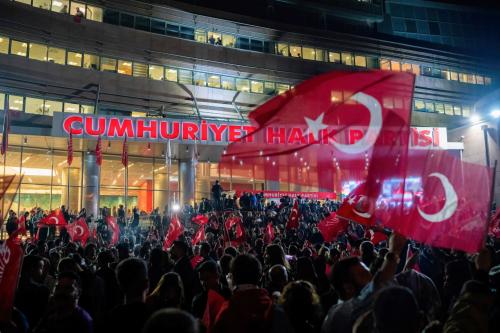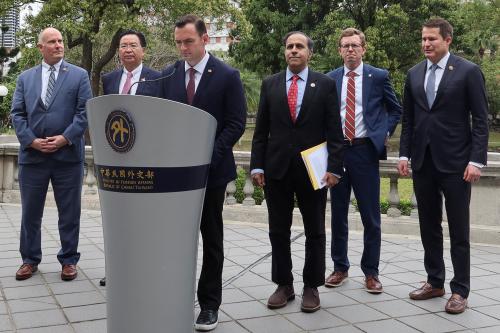Just when football passions start to simmer, fights for political power in Latin America are also in the making because 2014 will be a year of intense electoral activity in Latin America. More than 50% of Latin American citizens will be summoned to cast their vote. There will be seven presidential elections in total—in Costa Rica, El Salvador, Panama, Colombia, Bolivia, Brazil and Uruguay—and local, regional, and legislative elections in Ecuador, Colombia, Peru, and Haiti. And, also this year (who can forget!) the FIFA World Cup will be held in Brazil.
Poverty, inequality, and lack of security persist
Between the years 2013-16, all of the 18 Latin American nations (except Mexico) will hold presidential elections. This year, elections will be held against a backdrop of moderate economic growth (slightly higher than in 2013) of 3.2% as forecasted by the United Nations Economic Commission for Latin America and the Caribbean (ECLAC), compared to 2.6% recorded last year. In spite of the important achievements of recent years, the figures for poverty and extreme poverty remain high: with 164 million people living in poverty and 66 million in extreme poverty. Latin America remains the most unequal region in the world and lack of security top citizens’ concerns in most of the countries. A sustainable improvement on this issue is not easy to achieve.
In the political field—while acknowledging the meaningful progress made in the last three decades— serious threats remain: such as populist regimes, hyper-presidential rule, re-election fever, corruption, weak rule of the law, and limits on freedom of speech.
There is also a growing level of discontent of the emerging middle classes, as was made clear in 2013 by student demonstrations in Chile and protests in Argentina, Brazil, Colombia, and Peru, demanding improved public services, less corruption, and more transparency.
Preservation of status quo rules
The electoral calendar includes three Central American countries (Costa Rica, El Salvador, and Panama) and four in South America (Bolivia, Colombia, Brazil, and Uruguay). The political heterogeneity which characterizes the region is evident in these elections, with three major political trends in each race. The right and center-right want to continue ruling in Colombia and Panama, while in El Salvador they want to recover power. The moderate left is likely to win in Brazil and Uruguay; it might also do so in El Salvador; and “21st Century Socialism” will remain in Bolivia. The major trend is preservation of the status quo. The candidates of the ruling parties are clear favorites in five of the seven elections: Cambio Democrático in Panama; Santos followers in Colombia; MAS in Bolivia; the PT in Brazil; and Frente Amplio in Uruguay. On the other hand, in Costa Rica and El Salvador there is a virtual tie in levels of support for the two leading candidates which, if it persists, (elections in both countries will are set for February 2) might force a second round.
Victories by ruling parties are strengthened for three presidents who will seek a consecutive term (in the case of Santos, Rousseff and Morales), and two former presidents (Vasquez in Uruguay and Saca in El Salvador)who, via the alternate reelection rule, are trying to come back.
This exposes the weakness of a majority of the opposition parties which, in an important number of countries, have shown that they are not seen as credible alternatives by the population.
In at least five of those seven processes a second round may be necessary. The two exceptions are Panama (where it is not regulated) and Bolivia (where Evo Morales is likely to win in the first round). So far, and according to surveys, no candidate is likely to obtain the necessary percentage of the vote to win in the first round. However, not all of those second rounds will be similar. In Brazil and Colombia, everything points to easy wins by Rousseff and Santos. In El Salvador, the fight will be between ruling party candidate Sanchez-Ceren (FMLN) and right-winger Norman Quijano (ARENA).
A similar case is likely in Costa Rica, as a consequence of the apparent technical three-pronged tie between Araya (of the ruling PLN), Villalta (left FA) and Guevara (center-right ML), which makes it difficult to forecast who will go on to a second round. A second round is also probable in Uruguay, even though the candidate from the ruling party –Tabare Vasquez—is clearly in the lead.
Processes which deserve follow-up
How will the World Cup impact on the presidential elections in Brazil in October? How will the peace negotiations in Colombia fare next to the legislative elections in March and a presidential election in May? And, in Mexico, what results should we start to see from the structural reforms approved last year? How will Enrique Peña-Nieto choose to address the lack of security and self-defense forces? This year it will be worthwhile closely following these processes and others which are of the utmost importance for the region.
Also, because there will be no elections, Venezuela faces an unusual year during which the Maduro regime (which is becoming even more radical) will have to tackle a delicate economic situation (high inflation and scarcity of goods), and high levels of insecurity (24,000 homicides every year). In Argentina, President Fernandez faces a complex year, with inflation over 25%, a growing fiscal deficit, a severe energy crisis, and strong loss of reserves. In the political field, a Kirchner cycle comes to an end and the opposition starts taking positions in the lead up to the 2015 presidential elections.
Meanwhile, in Honduras, Juan Orlando Hernandez takes office and will face his top opponent, Manuel Zelaya, in a very fragmented Congress where he does not have a majority. This Central American country already ails from the highest insecurity rate in the continent while its high poverty and corruption levels are difficult to combat.
In Chile, Michelle Bachelet returns to La Moneda Palace in March with high expectations. Among the things she expects to achieve is the approval of an ambitious reform agenda –educational, fiscal, constitutional, and political—to recharge the political system and to reduce inequality.
In addition, the United States will hold legislative elections and Obama’s achievements in his last two years as president will depend largely on the outcome. It is expected that some of the campaign issues will be related to Latin America, such as immigration.
Cuba will host the ECLAC meeting and it remains to be seen whether the strategy of controlled change, spearheaded by Raul Castro to boost the economy, will be successful without catalyzing changes in the regime’s political arena. It is also possible that a much awaited agreement with the European Union may be achieved to put an end to the institutional blockade that the island has suffered since 1996.
Finally, it will be a must to keep a finger on the pulse of the leading integration programs in the region: among them the stagnation of the Bolivarian Alliance for the Peoples of Our America (ALBA in Spanish), the energy of the Pacific Alliance, and a possible (and long hoped for) agreement between the Southern Common Market (MERCOSUR in Spanish) and the European Union.
Few new faces, many challenges
If my projections are confirmed, the seven 2014 presidential elections (plus the presidencies of Bachelet and Hernandez to begin this year) will not cause significant shifts in the regional political balance. Of these nine presidents, three will continue (Santos, Roussef, and Morales), two will return (Bachelet and Vasquez), and four will wear the presidential band for the first time (Hernandez in Honduras, Arias in Panama, and the winners in Costa Rica and El Salvador). In South America we will not see any new faces, and even though we may see them in Central America, in two of the four countries at least, they will be representatives of current ruling parties.
In South America, the moderate left will continue to hold on to power (in Argentina, Brazil, Chile, Peru and Uruguay), 21st Century Socialism will remain in Bolivia –plus in Ecuador and Venezuela— but it will not expand. The centre right will only be present in Colombia and Paraguay. The opposite will happen in Central America, where the centre right and the right will remain in power in Guatemala, Honduras, and Panama. It remains to be seen what will happen in the Costa Rica and El Salvador elections. In Nicaragua, the approval of indefinite reelection, destined to make the rule of President Ortega (also of the 21st Century Socialism school) permanent will further strengthen the authoritarian features of the regime and will bring tension to the political environment.
In a Latin American context of moderate economic growth and an electoral marathon, the governments will have to face the expectations and demands from the citizens in a more austere environment. As a consequence, social conflicts will remain present with demands that are not going to put at stake the continuity of democracy, but which are certainly going to make governability more complex. Let the games begin!
This article was translated into English by
International IDEA
, and was originally published in Spanish by
Revista Estrategia & Negocios
.


Commentary
Op-edLatin America in 2014: Elections and Football
January 23, 2014